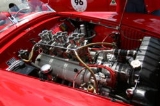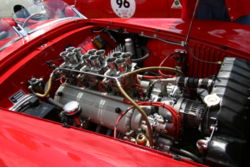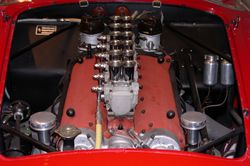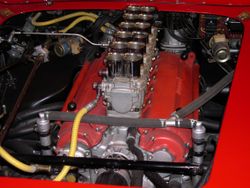
Ferrari Colombo engine
Encyclopedia
 |
 |
 |
 |
 |
Ferrari
Ferrari
Ferrari S.p.A. is an Italian sports car manufacturer based in Maranello, Italy. Founded by Enzo Ferrari in 1929, as Scuderia Ferrari, the company sponsored drivers and manufactured race cars before moving into production of street-legal vehicles as Ferrari S.p.A. in 1947...
's earliest cars used engines designed by Gioacchino Colombo
Gioacchino Colombo
Gioacchino Colombo was an Italian automobile engine designer.Colombo was born in Legnano. He began work as an apprentice to Vittorio Jano at Alfa Romeo. In 1937, Colombo designed the 158 engine for the Alfetta and caught the attention of Enzo Ferrari. Ferrari asked Colombo to design a small V12...
, who had formerly designed Alfa Romeo
Alfa Romeo
Alfa Romeo Automobiles S.p.A. is an Italian manufacturer of cars. Founded as A.L.F.A. on June 24, 1910, in Milan, the company has been involved in car racing since 1911, and has a reputation for building expensive sports cars...
s for Enzo Ferrari
Enzo Ferrari
Enzo Anselmo Ferrari Cavaliere di Gran Croce OMRI was an Italian race car driver and entrepreneur, the founder of the Scuderia Ferrari Grand Prix motor racing team, and subsequently of the Ferrari car manufacturer...
. These V12
V12 engine
A V12 engine is a V engine with 12 cylinders mounted on the crankcase in two banks of six cylinders, usually but not always at a 60° angle to each other, with all 12 pistons driving a common crankshaft....
powerplants ranged from the diminutive 1.5 L (1497 cc) unit fitted to the 125S
Ferrari 125 S
The Ferrari 125 S was the first vehicle produced and built by automaker Ferrari of Modena, Italy. Although preceded by Enzo Ferrari's Auto Avio Costruzioni 815 of 1940, the 125 S was the first vehicle to bear the Ferrari name when it debuted on May 11, 1947 at the Piacenza racing circuit...
to the 3.3 L (3285 cc) unit in the 1966 275
Ferrari 275
The Ferrari 275 was a 2-seat front-engined Gran Turismo automobile produced by Ferrari between 1964 and 1968. It used a 3.3 L Colombo 60° V12 engine and produced 280-300 hp. The Pininfarina-designed body was a graceful evolution of the car's predecessor, the 250, and strongly contrasted...
.
Enzo Ferrari had long admired the V12 engines of Packard
Packard
Packard was an American luxury-type automobile marque built by the Packard Motor Car Company of Detroit, Michigan, and later by the Studebaker-Packard Corporation of South Bend, Indiana...
, Auto Union
Auto Union
Auto Union was an amalgamation of four German automobile manufacturers, founded in 1932 and established in 1936 in Chemnitz, Saxony, during the Great Depression. The company has evolved into present day Audi, as a subsidiary of Volkswagen Group....
, and Alfa Romeo
Alfa Romeo
Alfa Romeo Automobiles S.p.A. is an Italian manufacturer of cars. Founded as A.L.F.A. on June 24, 1910, in Milan, the company has been involved in car racing since 1911, and has a reputation for building expensive sports cars...
(where he was long employed), but his first car, the 1940 Auto Avio Costruzioni 815
Auto Avio Costruzioni 815
The Auto Avio Costruzioni 815 was the first car to be fully designed and built by Enzo Ferrari. Legal issues with former associates Alfa Romeo prevented Ferrari from creating the Ferrari marque. The 815 raced at the 1940 Brescia Grand Prix, where both entries failed to finish due to engine problems...
, used a Fiat
Fiat
FIAT, an acronym for Fabbrica Italiana Automobili Torino , is an Italian automobile manufacturer, engine manufacturer, financial, and industrial group based in Turin in the Italian region of Piedmont. Fiat was founded in 1899 by a group of investors including Giovanni Agnelli...
straight-8
Straight-8
The straight-eight engine or inline-eight engine is an eight-cylinder internal combustion engine with all eight cylinders mounted in a straight line along the crankcase...
. It was only natural that his first homegrown engine would be a V12, and the same basic design would last many years, with development continuing long after original designer Colombo had been replaced by Aurelio Lampredi
Aurelio Lampredi
Aurelio Lampredi was an Italian automobile and aircraft engine designer.Born in Livorno, he began his career at Piaggio, makers of the Vespa scooter, but quickly moved up to larger engines...
as the company's marquee engine designer. Although Lampredi's engines
Ferrari Lampredi engine
Aurelio Lampredi designed a number of racing engines for Ferrari. He was brought on to hedge the company's bets with a different engine family than the small V12s designed by Gioacchino Colombo. Lampredi went on to design a number of different straight-4, straight-6, and V12 engines through the...
were a real force for the company, it was Colombo's V12 which would be the primary motivator for the company's consumer products through the 1950s and 1960s.
125
The first homegrown Ferrari engine was the 125. First appearing May 11, 1947 under the hood of Ferrari's 125 SFerrari 125 S
The Ferrari 125 S was the first vehicle produced and built by automaker Ferrari of Modena, Italy. Although preceded by Enzo Ferrari's Auto Avio Costruzioni 815 of 1940, the 125 S was the first vehicle to bear the Ferrari name when it debuted on May 11, 1947 at the Piacenza racing circuit...
sports racer, the engine allowed the company to claim six victories in 14 races that year. The 125 S sported tiny 55.0 mm (2.2 in) by 52.5 mm (2.1 in) cylinders, the resulting 124.73 cc of each cylinder rounded up to give the engine, and the car, its name. Overall, the engine displaced exactly 1,496.77 cc (91 in³). It had a single overhead camshaft on each bank of cylinders with a 60° angle between the two banks. The engine had two valves per cylinder fed through three Weber 30DCF carburettors. A 7.5:1 compression ratio
Compression ratio
The 'compression ratio' of an internal-combustion engine or external combustion engine is a value that represents the ratio of the volume of its combustion chamber from its largest capacity to its smallest capacity...
yielded 118 hp (88 kW) at 6800 rpm.
Colombo and Ferrari had designed the engine with Formula One
Formula One
Formula One, also known as Formula 1 or F1 and referred to officially as the FIA Formula One World Championship, is the highest class of single seater auto racing sanctioned by the Fédération Internationale de l'Automobile . The "formula" designation in the name refers to a set of rules with which...
regulations in mind, and introduced it the next year in the company's first F1 car, the 125 F1
Ferrari 125 F1
The 125 F1 was Ferrari's first Formula One car. It shared its engine with the 125 S sports racer which preceded it by a year, but was developed at the same time by Enzo Ferrari and famed designer, Gioacchino Colombo....
. This time, it was supercharged, in accordance with F1 dictates, for a total output of 230 hp (172 kW) at 7,000 rpm. However, the Roots-type single-stage supercharger was incapable of producing the high-end power required to compete with the strong eight-cylinder Alfa Romeo 158 and four-cylinder Maserati 4CLT. Strong driving and a nimble chassis, however, allowed the company to place third in its first outing, at the Valentino Grand Prix on September 5, 1948 and the company persevered in racing.
For 1949, the engine was further modified with dual overhead camshafts (though still two valves per cylinder) and a two-stage supercharger. This combination gave the car better top-end performance and the resulting 280 hp (209 kW) gave it five Grand Prix wins. Development continued the following year, but the problematic superchargers were dropped in favor of larger displacement and Lampredi's 275 engine
Ferrari Lampredi engine
Aurelio Lampredi designed a number of racing engines for Ferrari. He was brought on to hedge the company's bets with a different engine family than the small V12s designed by Gioacchino Colombo. Lampredi went on to design a number of different straight-4, straight-6, and V12 engines through the...
superseded the original Ferrari engine.
Applications:
- 1947 Ferrari 125 SFerrari 125 SThe Ferrari 125 S was the first vehicle produced and built by automaker Ferrari of Modena, Italy. Although preceded by Enzo Ferrari's Auto Avio Costruzioni 815 of 1940, the 125 S was the first vehicle to bear the Ferrari name when it debuted on May 11, 1947 at the Piacenza racing circuit...
— 118 hp - 1948 Ferrari 125 F1Ferrari 125 F1The 125 F1 was Ferrari's first Formula One car. It shared its engine with the 125 S sports racer which preceded it by a year, but was developed at the same time by Enzo Ferrari and famed designer, Gioacchino Colombo....
— Single supercharger, 230 hp - 1949–1950 Ferrari 125 F1Ferrari 125 F1The 125 F1 was Ferrari's first Formula One car. It shared its engine with the 125 S sports racer which preceded it by a year, but was developed at the same time by Enzo Ferrari and famed designer, Gioacchino Colombo....
— Dual-stage supercharger, 280 hp
58.8 mm stroke
The early 166, 195, and 212 cars used Colombo V12s of varying sizes. All shared the same 58.8 mm (2.3 in) stroke, with 60, 65, and 68 mm (2.7 in) bores giving displacements of 1995, 2341, and 2563 cc in the 166Ferrari 166
Ferrari used its 2 L V12 engine in a number of models, all called 166 for the displacement of a single cylinder. Most early 166es were sports cars built for racing, though a later line of GT cars launched the company's street model line.The following models used the 166 name:* 1948 Ferrari...
, 195, and 212 respectively. Output ranged from 105 hp to 165 hp.
250
One of the most common Colombo engines is the 250. It bowed in 1952 in the 250SFerrari 250
The Ferrari 250 is a sports car built by Ferrari from 1953 to 1964. The company's most successful early line, the 250 series included several variants. It was replaced by the 275 and the 330.-Similarities:...
and lasted through the 1963 330 America
Ferrari 330
The 1963 330 America shared the outgoing 250 GTE's chassis but not its engine, being powered by the new Type 209, at 6600 rpm, 4.0 L engine.Socialite Sandra West is buried with her blue 330 America at the Alamo Masonic Cemetery at San Antonio, Texas....
. It used a 73 mm (2.9 in) bore with the common Colombo stroke of 58.8 mm (2.3 in) for a total of 2953 cc.
275
The final 58.8 mm (2.3 in) Colombo Ferrari was the 275Ferrari 275
The Ferrari 275 was a 2-seat front-engined Gran Turismo automobile produced by Ferrari between 1964 and 1968. It used a 3.3 L Colombo 60° V12 engine and produced 280-300 hp. The Pininfarina-designed body was a graceful evolution of the car's predecessor, the 250, and strongly contrasted...
. It used a 3286 cc variant of the V12 with a wide 77 mm (3 in) bore for up to 300 hp.
330
The 1960 400 SuperamericaFerrari America
The first America cars were the 340, produced between 1950 and 1952. Using the new Lampredi V12 developed for Formula One racing, the 340 America could produce over...
replaced the previous model's Lampredi engine with a 3967 cc Colombo. It diverged from the standard 58.8 mm (2.3 in) stroke with a 71 mm (2.8 in) stroke and 77 mm (3 in) bore. Output was 340 to 400 hp with triple Weber carburetor
Weber carburetor
Weber is an Italian company producing carburetors, currently owned by Magneti Marelli Powertrain S.p.A., in turn part of the Fiat Group.The company was established as...
s.
Although the 1963 330 series
Ferrari 330
The 1963 330 America shared the outgoing 250 GTE's chassis but not its engine, being powered by the new Type 209, at 6600 rpm, 4.0 L engine.Socialite Sandra West is buried with her blue 330 America at the Alamo Masonic Cemetery at San Antonio, Texas....
also used a 3967 cc engine with the same bore and stroke as the 400 Superamerica, this engine was quite different. It used a wider bore spacing, paving the way for future displacement increases. The spark plugs were moved and a new water pump was used. The dynamo on the prior versions was replaced by a true alternator. In the end, 300 hp (223 kW) was on tap.
Four-cam
The Colombo V12 was substantially reworked for 1967's 275 GTB/4. It still used two valves per cylinder, but dual overhead cams were now used as well. In a departure from previous Ferrari designs, the valve angle was reduced three degrees to 54° for a more-compact head. The dual camshafts also allowed the valves to be aligned "correctly" (perpendicular to the camshaft) instead of offset as in SOHC Ferraris. It was a dry-sump design with a huge 17 qt (16 L) capacity. The engine retained the bore and stroke dimensions of the 275 model for 3286 cc of displacement. Output was 330 hp (246 kW) at 8000 rpm and 240 ft.lbf (325 Nm) at 6000 rpm with six Weber 40 DCN 9 carburetorCarburetor
A carburetor , carburettor, or carburetter is a device that blends air and fuel for an internal combustion engine. It is sometimes shortened to carb in North America and the United Kingdom....
s.
365
The 71 mm (2.8 in) Colombo engine was enlarged with an 81 mm (3.2 in) bore to 4390 cc for 1966's 365Ferrari 365
The Ferrari 365 is Ferrari's large FR layout grand tourer and 2+2 line. Introduced at the 1966 Geneva Motor Show, it replaced the 330 and 500 Superfast. Featuring evolutionary Pininfarina styling, it is nevertheless often overshadowed by its famous successor, the sharp-creased 365 GTB/4...
models. This same engine would continue for the Daytona
Ferrari Daytona
The Ferrari 365 GTB/4, better known by the unofficial name Ferrari Daytona, is a Gran Turismo automobile produced from 1968 to 1973. It was first introduced to the public at the Paris Auto Salon in 1968 and replaced the 275 GTB/4...
and was flattened
Flat engine
A flat engine is an internal combustion engine with multiple pistons that move in a horizontal plane. Typically, the layout has cylinders arranged in two banks on either side of a single crankshaft and is sometimes known as the boxer, or horizontally opposed engine. The concept was patented in 1896...
for use in the 365 GT4 BB
Ferrari Berlinetta Boxer
A Ferrari Berlinetta Boxer is one of a series of cars produced by Ferrari in Italy between 1973 and 1984. They used a mid-mounted flat-12 engine, replacing the FR layout Daytona, and were succeeded in the Ferrari stable by the Testarossa. It was designed by Leonardo Fioravanti.Production of the...
of 1971.
400
The Colombo engine was enlarged again to 4823 cc for 1976's 400Ferrari 400
The Ferrari 400 and Ferrari 412 are front-engined 2+2 coupé cars from Italian manufacturer Ferrari. They were available with 5-speed all synchromesh or an optional 3-speed automatic transmission unit from General Motors. Their design was derived from the almost identical looking 365 GT4 2+2...
with the same 81 mm (3.2 in) bore and a 78 mm (3.1 in) stroke.
Applications:
- 1983–1985 400iFerrari 400The Ferrari 400 and Ferrari 412 are front-engined 2+2 coupé cars from Italian manufacturer Ferrari. They were available with 5-speed all synchromesh or an optional 3-speed automatic transmission unit from General Motors. Their design was derived from the almost identical looking 365 GT4 2+2...
512
Another flat version (bored to 82 mm) was fitted to the 512BBFerrari Berlinetta Boxer
A Ferrari Berlinetta Boxer is one of a series of cars produced by Ferrari in Italy between 1973 and 1984. They used a mid-mounted flat-12 engine, replacing the FR layout Daytona, and were succeeded in the Ferrari stable by the Testarossa. It was designed by Leonardo Fioravanti.Production of the...
.
- Fuel-injected
- 1981–1985 512 BBiFerrari Berlinetta BoxerA Ferrari Berlinetta Boxer is one of a series of cars produced by Ferrari in Italy between 1973 and 1984. They used a mid-mounted flat-12 engine, replacing the FR layout Daytona, and were succeeded in the Ferrari stable by the Testarossa. It was designed by Leonardo Fioravanti.Production of the...
- 1981–1985 512 BBi
- Tipo F113B
- 1985–1991 TestarossaFerrari TestarossaThe Ferrari Testarossa is a 12-cylinder mid-engine sports car manufactured by Ferrari, which went into production in 1984 as the successor to the Ferrari Berlinetta Boxer...
- 1985–1991 Testarossa
- Tipo F101
- 1986–1988 412iFerrari 400The Ferrari 400 and Ferrari 412 are front-engined 2+2 coupé cars from Italian manufacturer Ferrari. They were available with 5-speed all synchromesh or an optional 3-speed automatic transmission unit from General Motors. Their design was derived from the almost identical looking 365 GT4 2+2...
- 1986–1988 412i
- Tipo F113G
- 1992–1995 512 TRFerrari TestarossaThe Ferrari Testarossa is a 12-cylinder mid-engine sports car manufactured by Ferrari, which went into production in 1984 as the successor to the Ferrari Berlinetta Boxer...
- 1992–1995 512 TR

